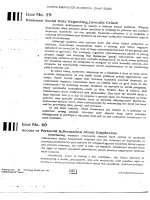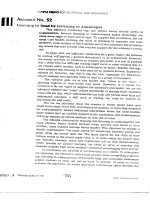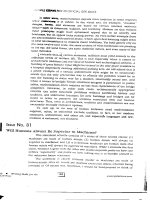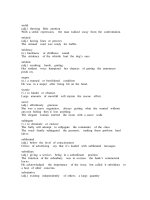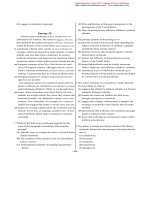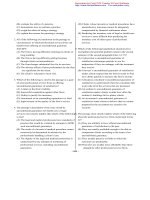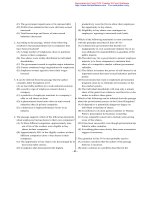GMAT reading Episode 2 Part 3 doc
Bạn đang xem bản rút gọn của tài liệu. Xem và tải ngay bản đầy đủ của tài liệu tại đây (172.6 KB, 10 trang )
- 81 -
(D) An analysis of the causes of a phenomenon
(E) An argument in favor of revising a view
2. According to the author, which of the following is true
of
Glarthaar’s Forged in Battle compared with previous
studies
on the same topic?
(A) It is more reliable and presents a more complete
picture
of the historical events on which it concentrates than
do
previous studies.
(B) It uses more of a particular kind of source material
and
focuses more closely on a particular aspect of the
topic
than do previous studies.
(C) It contains some unsupported generalizations, but it
rightly emphasizes a theme ignored by most
previous
studies.
(D) It surpasses previous studies on the same topic in
that it
accurately describes conditions often neglected by
those
studies.
(E) It makes skillful use of supporting evidence to
illustrate a
subtle trend that previous studies have failed to
detect.
3. The author implies that the title of Glatthaar’s book
refers
specifically to which of the following?
(A) The sense of pride and accomplishment that Black
soldiers increasingly felt as a result of their Civil
War
experiences
(B) The civil equality that African Americans achieved
after
the Civil War, partly as a result of their use of
organizational skills honed by combat
(C) The changes in discriminatory army policies that
were
made as a direct result of the performance of Black
combat units during the Civil War
(D) The improved interracial relations that were formed
by
the races’ facing of common dangers and their
waging
of a common fight during the Civil War
(E) The standards of racial egalitarianism that came to
be
adopted as a result of White Civil War veterans’
repudiation of the previous racism
4. The passage mentions which of the following as an
important theme that receives special emphasis in
Glarthaar’s book?
(A) The attitudes of abolitionist officers in Black units
(B) The struggle of Black units to get combat
assignments
(C) The consequences of the poor medical care received
by
Black soldiers
(D) The motives of officers serving in Black units
(E) The discrimination that Black soldiers faced when
trying
for promotions
5. The passage suggests that which of the following was
true of
Black units’ disease mortality rates in the Civil War?
(A) They were almost as high as the combat mortality
rates
of White units.
(B) They resulted in part from the relative inexperience
of
these units when in combat.
(C) They were especially high because of the nature of
these
Generated by Foxit PDF Creator © Foxit Software
For evaluation only.
- 82 -
units’ usual duty assignments.
(D) They resulted in extremely high overall casualty
rates in
Black combat units.
(E) They exacerbated the morale problems that were
caused
by the army’s discriminatory policies.
6. The author of the passage quotes the White officer in
lines
23-24 primarily in order to provide evidence to support
the
contention that
(A) virtually all White officers initially had hostile
attitudes
toward Black soldiers
(B) Black soldiers were often forced to defend
themselves
from physical attacks initiated by soldiers from
White
units
(C) the combat performance of Black units changed the
attitudes of White soldiers toward Black soldiers
(D) White units paid especially careful attention to the
performance of Black units in battle
(E) respect in the army as a whole was accorded only to
those units, whether Black or White, that performed
well
in battle
7. Which of the following best describes the kind of error
attributed to Glarthaar in lines 25-28?
(A) Insisting on an unwarranted distinction between two
groups of individuals in order to render an argument
concerning them internally consistent
(B) Supporting an argument in favor of a given
interpretation
of a situation with evidence that is not particularly
relevant to the situation
(C) Presenting a distorted view of the motives of certain
individuals in order to provide grounds for a
negative
evaluation of their actions
(D) Describing the conditions prevailing before a given
event in such a way that the contrast with those
prevailing after the event appears more striking than
it
actually is
(E) Asserting that a given event is caused by another
event
merely because the other event occurred before the
given
event occurred
8. Which of the following actions can best be described as
indulging in “generational chauvinism” (lines 40-41) as
that
practice is defined in the passage?
(A) Condemning a present-day monarch merely because
many monarchs have been tyrannical in the past.
(B) Clinging to the formal standards of politeness
common
in one’s youth to such a degree that any relaxation of
those standards is intolerable
(C) Questioning the accuracy of a report written by an
employee merely because of the employee’s gender.
(D) Deriding the superstitions accepted as “science” in
past
eras without acknowledging the prevalence of
irrational
beliefs today.
(E) Labeling a nineteenth-century politician as “corrupt”
for engaging in once-acceptable practices considered
intolerable today.
Passage 41
It was once assumed that all living things could be
divided into two fundamental and exhaustive categories.
Multicellular plants and animals, as well as many unice
llu-
lar organisms, are eukaryotic—their large, complex cells
(5
)
have a well-formed nucles and many organelles. On the
Generated by Foxit PDF Creator © Foxit Software
For evaluation only.
- 83 -
other hand, the true bacteria are prokaryotic cell, which
are simple and lack a nucleus. The distinction between
eukaryotes and bacteria, initially defined in terms of
subcellular structures visible with a microscope,
was ulti
-
(10
)
mately carried to the molecular
level. Here
prokaryotic and
eukaryotic cells have many features in common. For
instance, they translate genetic information into proteins
according to the same type of genetic coding. But even
where the molecular processes are the same,
the details in
(15
)
the two forms are different and
characteristic of the respec-
tive forms. For example, the
amino acid sequences of vari-
ous
enzymes tend to be typically
prokaryotic or eukaryotic.
The differences between the groups and the similarities
within each group made it seem certain to most
biologists
(20)
that the tree of life had only two stems. Moreover,
argu-
ments pointing out the extent of both structural and func-
tional differences between eukaryotes and true bacteria
convinced many biologists that the precursors of the
eukaryotes must have diverged from the common
(25)
ancestor before the bacteria arose.
Although much of this picture has been sustained by
more recent research, it seems fundamentally wrong in
one
respect. Among the bacteria, there are organisms that are
significantly different both from the cells
of eukaryotes and
(30)
from the true bacteria, and it now appears that there are
three stems in the tree of life. New techniques for deter-
mining the molecular sequence of the RNA of organisms
have produced evolutionary information about the degree
to which organisms are related, the time since they
diverged
(35)
from a common ancestor, and the
reconstruction of ances-
tral versions of genes. These techniques have strongly
suggested that although the true bacteria indeed form a
large coherent group, certain othe
r bacteria, the archaebac-
teria, which are also prokaryotes and
which resemble true
(40
)
bacteria, represent a distinct evolutionary branch that
far antedates the common ancestor of all true bacteria.
1. The passage is primarily concerned with
(A) detailing the evidence that has led most biologists to
replace the trichotomous picture of living organisms
with a dichotomous one
(B) outlining the factors that have contributed to the
current hypothesis concerning the number of basic
categories of living organisms
(C) evaluating experiments that have resulted in proof
that the prokaryotes are more ancient than had been
expected.
(D) summarizing the differences in structure and
function found among true bacteria, archaebacteria,
and eukaryotes
(E) formulating a hypothesis about the mechanisms of
evolution that resulted in the ancestors of the
prokaryotes
2. According to the passage, investigations of eukaryotic
and prokaryotic cells at the molecular level supported
the conclusion that
(A) most eukaryotic organisms are unicellular
(B) complex cells have well-formed nuclei
(C) prokaryotes and cukaryotes form two fundamental
categories
(D) subcellular structures are visible with a microscope
(E) prokaryotic and eukaryotic cells have similar
enzymes
3. According to the passage, which of the following
statements about the two-category hypothesis is likely to
be true?
(A) It is promising because it explains the presence of
true
bacteria-like organisms such as organelles in
eukaryotic cells.
(B) It is promising because it explains why eukaryotic
cells, unlike prokaryotic cells, tend to form
multicellular organisms.
(C) It is flawed because it fails to account for the great
variety among eukaryotic organisms.
(D) It is flawed because it fails to account for the
similarity between prokaryotes and eukaryotes.
(E) It is flawed because it fails to recognize an important
distinction among prokaryotes.
Generated by Foxit PDF Creator © Foxit Software
For evaluation only.
- 84 -
4. It can be inferred from the passage that which of the
following have recently been compared in order to
clarify the fundamental classifications of living things?
(A) The genetic coding in true bacteria and that in other
prokaryotes
(B) The organelle structures of archaebacteria, true
bacteria, and eukaryotes
(C) The cellular structures of multicellular organisms
and unicellular organisms
(D) The molecular sequences in eukaryotic RNA, true
bacterial RNA, and archaebacterial RNA
(E) The amino acid sequences in enzymes of various
eukaryotic species and those of enzymes in
archaebecterial species
5. If the “new techniques” mentioned in line 31 were
applied in studies of biological classifications other than
bacteria, which of the following is most likely?
(A) Some of those classifications will have to be
reevaluated.
(B) Many species of bacteria will be reclassified
(C) It will be determined that there are four main
categories of living things rather than three.
(D) It will be found that true bacteria are much older
than eukaryotes.
(E) It will be found that there is a common ancestor of
the eukaryotes, archaebacteria, and true bacteria.
6. According to the passage, researchers working under the
two-category hypothesis were correct in thinking that
(A) prokaryotes form a coherent group
(B) the common ancestor of all living things had
complex
properties
(C) eukaryotes are fundamentally different from true
bacteria
(D) true bacteria are just as complex as eukaryotes
(E) ancestral versions of eukaryotic genes functioned
differently from their modern counterparts.
7. All of the following statements are supported by the
passage
EXCEPT:
(A) True bacteria form a distinct evolutionary group.
(B) Archaebacteria are prokaryotes that resemble true
bacteria.
(C) True bacteria and eukaryotes employ similar types
of
genetic coding.
(D) True bacteria and eukaryotes are distinguishable at
the
subcellular level.
(E) Amino acid sequences of enzymes are uniform for
eukaryotic and prokaryotic organisms.
8. The author’s attitude toward the view that living things
are
divided into three categories is best described as one of
(A) tentative acceptance
(B) mild skepticism
(C) limited denial
(D) studious oriticism
(E) whole hearted endorsement
Passage 42
Excess inventory, a massive problem for many busi-
nesses, has several causes, some of which
are unavoidable
.
Overstocks may accumulate
through production overruns or
errors. Certain styles and colors prove unpopular. With
(5)
some products—computers and software, toys, and
books—last year’s models are difficult to move even at
huge discounts. Occasionally the
competition introduces a
better product. But in many cases
the public’s buying tastes
simply change, leaving a manufacturer or
distributor with
(10 )
thousands (or millions) of items that the
fickle public no
longer wants.
One common way to dispose of this
merchandise is to
sell it to a liquidator,
who buys as cheaply
as
possible and
then resells the merchandise through
catalogs, discount
(15)
stores, and other
outlets. However, liquidators may pay less
Generated by Foxit PDF Creator © Foxit Software
For evaluation only.
- 85 -
for the merchandise than it cost to
make it. Another way to
dispose of excess inventory is to
dump it. The corporation
takes a straight cost write-off on its taxes and hauls the
merchandise to a landfill. Although
it is hard to believe,
(20)
there is a sort of convoluted logic to this approach. It is
perfectly legal, requires little time or
preparation on the
company’s part, and solves the
problem quickly. The draw-
back is the remote possibility
of getting caught by the news
media. Dumping perfectly useful product
s can turn into a
(25)
public relations nightmare. Children
living in poverty are
freezing and XYZ Company has just sent
500 new snow
-
suits to the local dump. Parents of young
children are
barely getting by and QPS
Company dumps 1,000 cases of
disposable diapers because they have
slight imperfections.
(30)
The managers of these companies are not deliberately
wasteful; they are simply unaware of all
their alternatives.
In 1976 the Internal Revenue Service
provided a tangible
incentive for businesses to contribute
their products to char-
ity. The new tax law allowed corporations to deduct the
(35
)
cost of the product donated plus half the difference
between cost and fair market selling
price,
with the proviso
that deductions cannot exceed twice cost.
Thus, the federal
government sanctions—indeed,
encourages—an above-cost
federal tax deduction for companies
that donate inventory
to charity.
1. The author mentions each of the following as a cause of
excess inventory EXCEPT
(A) production of too much merchandise
(B) inaccurate forecasting of buyers’ preferences
(C) unrealistic pricing policies
(D) products’ rapid obsolescence
(E) availability of a better product
2. The passage suggests that which of the following is a
kind of product that a liquidator who sells to discount
stores would be unlikely to wish to acquire?
(A) Furniture
(B) Computers
(C) Kitchen equipment
(D) Baby-care products
(E) Children’s clothing
3. The passage provides information that supports which of
the following statements?
(A) Excess inventory results most often from
insufficient market analysis by the manufacturer.
(B) Products with slight manufacturing defects may
contribute to excess inventory.
(C) Few manufacturers have taken advantage of the
changes in the federal tax laws.
(D) Manufacturers who dump their excess inventory are
often caught and exposed by the news media.
(E) Most products available in discount stores have
come from manufacturers’ excess-inventory stock.
4. The author cites the examples in lines 25-29 most
probably in order to illustrate
(A) the fiscal irresponsibility of dumping as a policy for
dealing with excess inventory
(B) the waste-management problems that dumping new
products creates
(C) the advantages to the manufacturer of dumping as a
policy
(D) alternatives to dumping explored by different
companies
(E) how the news media could portray dumping to the
detriment of the manufacturer’s reputation
5. By asserting that manufacturers “are simply unaware”
(line 31), the author suggests which of the following?
(A) Manufacturers might donate excess inventory to
charity rather than dump it if they knew about the
provision in the federal tax code.
(B) The federal government has failed to provide
sufficient encouragement to manufacturers to make
use of advantageous tax policies.
(C) Manufacturers who choose to dump excess
inventory are not aware of the possible effects on
their reputation of media coverage of such dumping.
(D) The manufacturers of products disposed of by
dumping are unaware of the needs of those people
Generated by Foxit PDF Creator © Foxit Software
For evaluation only.
- 86 -
who would find the products useful.
(E) The manufacturers who dump their excess inventory
are not familiar with the employment of liquidators
to dispose of overstock.
6. The information in the passage suggests that which of
the following, if true, would make donating excess inv
entory to charity less attractive to manufacturers than
dumping?
(A) The costs of getting the inventory to the charitable
destination are greater than the above-cost tax
deduction.
(B) The news media give manufacturers’ charitable
contributions the same amount of coverage that they
give dumping.
(C) No straight-cost tax benefit can be claimed for items
that are dumped.
(D) The fair-market value of an item in excess inventory
is 1.5 times its cost.
(E) Items end up as excess inventory because of a
change in the public’s preferences.
7. Information in the passage suggests that one reason
manufacturers might take advantage of the tax provision
mentioned in the last paragraph is that
(A) there are many kinds of products that cannot be
legally dumped in a landfill
(B) liquidators often refuse to handle products with
slight imperfections
(C) the law allows a deduction in excess of the cost of
manufacturing the product
(D) media coverage of contributions of excess-inventory
products to charity is widespread and favorable
(E) no tax deduction is available for products dumped or
sold to a liquidator
Passage 43
Historians of women’s labor in the United
States at first
largely disregarded the story of female service workers
-women earning wages in occupations
such as salesclerk.
domestic servant, and office secretary. These historians
(5)
focused instead on factory work, primarily because it
seemed so different from traditional,
unpaid “women’s
work” in the home, and because the
underlying economic
forces of industrialism were presumed
to be gender-blind
and hence emancipatory in effect.
Unfortunately, emanci-
(10)
pation has been less profound
than expected, for not even
industrial wage labor has escaped continued sex segre-
gation in the workplace.
To explain this unfinished revolution in the status of
women, historians have recently begun to
emphasize the
( 15)
way a prevailing definition of femininity
often etermines
the kinds of work allocated to women, even when such
allocation is inappropriate to new
conditions. For instance,
early textile-mill entrepreneurs, in justifying women’s
employment in wage labor, made muc
h of the assumption
(20)
that women were by nature skillful at
detailed tasks and
patient in carrying out repetitive chores; the
mill owners
thus imported into the new industrial order hoary
stereo-
types associated with the homemaking
activities they
presumed to have been the purview of women.
Because
(25)
women accepted the more
unattractive new industrial tasks
more readily than did men, such jobs
came to be regarded
as female jobs. And
employers,
who assumed that women’s
“real” aspirations were for marriage and family life.
declined to pay women wages
commensurate with those of
(30)
men. Thus many lower-skilled,
lower-paid, less secure jobs
came to be perceived as “female.”
More remarkable than the origin has
been the persistence
of such sex segregation in twentieth-
century industry. Once
an occupation came to be perceived as
“female.” employers
(35)
showed surprisingly little interest in changing that
perception, even when higher
profits
beckoned. And despite
the urgent need of the United States during the Second
World War to mobilize its human resources fully, job
segregation by sex characterized even the
most important
40)
war industries. Moreover, once the
war ended, employers
quickly returned to men most of the “male” jobs that
women had been permitted to master.
1. According to the passage, job segregation by sex in the
Generated by Foxit PDF Creator © Foxit Software
For evaluation only.
- 87 -
United States was
(A) greatly diminlated by labor mobilization during the
Second World War
(B) perpetuated by those textile-mill owners who argued
in favor of women’s employment in wage labor
(C) one means by which women achieved greater job
security
(D) reluctantly challenged by employers except when
the economic advantages were obvious
(E) a constant source of labor unrest in the young textile
industry
2. According to the passage, historians of women’s labor
focused on factory work as a more promising area of
research than service-sector work because factory work
(A) involved the payment of higher wages
(B) required skill in detailed tasks
(C) was assumed to be less characterized by sex
segregation
(D) was more readily accepted by women than by men
(E) fitted the economic dynamic of industrialism better
3. It can be inferred from the passage that early historians
of women’s labor in the United States paid little
attention to women’s employment in the service sector
of the economy because
(A) the extreme variety of these occupations made it
very difficult to assemble meaningful statistics about
them
(B) fewer women found employment in the service
sector than in factory work
(C) the wages paid to workers in the service sector were
much lower than those paid in the industrial sector
(D) women’s employment in the service sector tended to
be much more short-term than in factory work
(E) employment in the service sector seemed to have
much in common with the unpaid work associated
with homemaking
4. The passage supports which of the following statements
about the early mill owners mentioned in the second
paragraph?
(A) They hoped that by creating relatively unattractive
“female” jobs they would discourage women from
losing interest in marriage and family life.
(B) They sought to increase the size of the available
labor force as a means to keep men’s to keep men’s
wages low.
(C) They argued that women were inherently suited to
do well in particular kinds of factory work.
(D) They thought that factory work bettered the
condition of women by emancipating them from
dependence on income earned by men.
(E) They felt guilty about disturbing the traditional
division of labor in family.
5. It can be inferred from the passage that the “unfinished
revolution” the author mentions in line 13 refers to
the
(A) entry of women into the industrial labor market
(B) recognition that work done by women as
homemakers should be compensated at rates
comparable to those prevailing in the service sector
of the economy
(C) development of a new definition of femininity
unrelated to the economic forces of industrialism
(D) introduction of equal pay for equal work in all
professions
(E) emancipation of women wage earners from gender-
determined job allocation
6. The passage supports which of the following statements
about hiring policies in the United States?
(A) After a crisis many formerly “male” jobs are
reclassified as “female” jobs.
(B) Industrial employers generally prefer to hire women
with previous experience as homemakers.
(C) Post-Second World War hiring policies caused
women to lose many of their wartime gains in
employment opportunity.
(D) Even war industries during the Second World War
were reluctant to hire women for factory work.
Generated by Foxit PDF Creator © Foxit Software
For evaluation only.
- 88 -
(E) The service sector of the economy has proved more
nearly gender-blind in its hiring policies than has the
manufacturing sector.
7. Which of the following words best expresses the opinion
of the author of the passage concerning the notion that
women are more skillful than men in carrying out
detailed tasks?
(A) “patient” (line 21)
(B) “repetitive” (line 21)
(C) “hoary” (line 22)
(D) “homemaking” (line 23)
(E) “purview” (line 24)
8. Which of the following best describes the relationship of
the final paragraph to the passage as a whole?
(A) The central idea is reinforced by the citation of
evidence drawn from twentieth-century history.
(B) The central idea is restated in such a way as to form
a transition to a new topic for discussion.
(C) The central idea is restated and juxtaposed with
evidence that might appear to contradic it.
(D) A partial exception to the generalizations of the
central idea is dismissed as unimportant.
(E) Recent history is cited to suggest that the central
idea’s validity is gradually diminishing.
Passage 44
According to a recent theory, Archean-age
gold-quartz
vein systems were formed over two
billion years ago from
magmatic fluids that originated from molten granitelike
bodies deep beneath the surface
of the Earth. This theory is
(
5)
contrary to the widely held view that
the systems were
deposited from metamorphic
fluids, that is, from fluids that
formed during the dehydration
of wet sedimentary rocks
.
he recently developed theory has considerable practical
importance. Most of the gold deposits
discovered during
(10)
the original gold rushes were
exposed at the Earth’s surface
and were found because they had shed trails of alluvial
gold that were easily
traced by simple prospecting methods.
Although these same methods
still lead to an occasional
discovery, most deposits not yet discovered have gone
(15)
undetected because they are buried
and have no surface
expression.
The challenge in exploration is therefore
to unravel the
subsurface geology of an area and
pinpoint the position of
buried minerals. Methods widely used today include
(20)
analysis of aerial images that yield a broad geological
overview; geophysical techniques that
provide data on the
magnetic, electrical, and mineralogical
properties of the
rocks being investigated; and sensitive
chemical tests tha
t
are able to detect the subtle chemical halos that often
(25)
envelop mineralization. However, none of these high-
technology methods are of any value if the
sites to which
they are applied have never mineralized,
and to maximize
the chances of discovery the explorer
must therefore pay
particular attention to selecting the
ground formations most
(30)
likely to be mineralized. Such ground selection relies to
varying degrees on conceptual models, which take into
account theoretical studies of relevant factors.
These models are constructed
primarily from empirical
observations of known mineral deposits
and from theories
35)
of ore-forming processes. The explorer
uses the models to
identify those geological features that are critical to the
formation of the mineralization being modeled, and then
tries to select areas for exploration that exhibit
as many of
the critical features as possible.
1. The author is primarily concerned with
(A) advocating a return to an older methodology
(B) explaining the importance of a recent theory
(C) enumerating differences between two widely used
methods
(D) describing events leading to a discovery
(E) challenging the assumptions on which a theory is
based
2. According to the passage, the widely held view of
Archean- age gold-quartz vein systems is that such
systems
Generated by Foxit PDF Creator © Foxit Software
For evaluation only.
- 89 -
(A) were formed from metamorphic fluids
(B) originated in molten granitelike bodies
(C) were formed from alluvial deposits
(D) generally have surface expression
(E) are not discoverable through chemical tests
3. The passage implies that which of the following steps
would be the first performed by explorers who wish to
maximize their chances of discovering gold?
(A) Surveying several sites known to have been formed
more than two billion years ago
(B) Limiting exploration to sites known to have been
formed from metamorphic fluid.
(C) Using an appropriate conceptual model to select a
site for further exploration
(D) Using geophysical methods to analyze rocks over a
broad area
(E) Limiting exploration to sites where alluvial gold has
previously been found
4. Which of the following statements about discoveries of
gold deposits is supported by information in the
passage?
(A) The number of gold discoveries made annually has
increased between the time of the original gold rushes
and the present.
(B) New discoveries of gold deposits are likely to be the
result of exploration techniques designed to locate
buried mineralization.
(C) It is unlikely that newly discovered gold deposits will
ever yield as much as did those deposits discovered
during the original gold rushes.
(D) Modern explorers are divided on the question of the
utility of simple prospecting methods as a source of
new discoveries of gold deposits.
(E) Models based on the theory that gold originated
from magmatic fluids have already led to new
discoveries of gold deposits.
5. It can be inferred from the passage that which of the
following is easiest to detect?
(A) A gold-quartz vein system originating in magmatic
fluids
(B) A gold-quartz vein system originating in
meamorphic fluids
(C) A gold deposit that is mixed with granite
(D) A gold deposit that has shed alluvial gold
(E) A gold deposit that exhibits chemical halos
6. The theory mentioned in line 1 relates to the conceptual
models discussed in the passage in which of the
following ways?
(A) It may furnish a valid account of ore-forming
processes, and, hence, can support conceptual
models that have great practical significance.
(B) It suggests that certain geological formations, long
believed to be mineralized, are in fact
mineralized, thus confirming current conceptual
models.
(C) It suggests that there may not be enough similarity
across Archean-age gold-quartz vein systems to
warrant the formulation of conceptual models.
(D) It corrects existing theories about the chemical
halos of gold deposits, and thus provides a
basis for correcting current conceptual models.
(E) It suggests that simple prospecting methods
still have a higher success rate in the discovery
of gold deposits than do more modern methods.
7. According to the passage, methods of exploring for gold
that are widely used today are based on which of the
following facts?
(A) Most of the Earth’s remaining gold deposits are still
molten.
(B) Most of the Earth’s remaining gold deposits are
exposed at the surface.
(C) Most of the Earth’s remaining gold deposits are
buried and have no surface expression.
(D) Only one type of gold deposit warrants exploration,
since the other types of gold deposits are found in
regions difficult to reach.
(E) Only one type of gold deposit warrants exploration,
Generated by Foxit PDF Creator © Foxit Software
For evaluation only.
- 90 -
since the other types of gold deposits are unlikely to
yield concentrated quantities of gold.
8. It can be inferred from the passage that the efficiency of
model-based gold exploration depends on which of the
following?
Ⅰ . The closeness of the match between the geological
features identified by the model as critical and the
actual geological features of a given area
Ⅱ . The degree to which the model chosen relies on
empirical observation of known mineral deposits
rather than on theories of ore-forming processes
Ⅲ . The degree to which the model chosen is based on
an accurate description of the events leading to
mineralization
(A) Ⅰ only
(B) Ⅱ only
(C) Ⅰ and Ⅱ only
(D) Ⅰ and Ⅲ only
(E) Ⅰ ,Ⅱ and Ⅲ
Passage 45
While there is no blueprint for transforming a largely
government-controlled economy into a free one, the
experience of the United Kingdom since 1979 clearly
shows one approach that works: privatization, in which
(5)
state-owned industries are sold to private companies. By
1979, the total borrowings and losses of state-owned
industries were running at about t3 billion a year. By
selling many of these industries, the government has
decreased these borrowings and losses, gained over t34
(10)
billion from the sales, and now receives
tax revenues from
the newly privatized companies.
Along wi
th a
dramatically
improved overall economy, the government
has been able
to repay 12.5 percent of the net national debt over a
two-year period.
(15
)
In fact, privatization has not only rescued individual
industries and a whole economy headed for
disaster, but
has also raised the level of performance
in every area. At
British Airways and British
Gas, for ex
ample,
productivity
per employee has risen by 20 percent. At associated
(20)
British Ports, labor disruptions common
in the 1970’s and
early 1980’s have now virtually
disappeared. At British
Telecom, there is no longer
a waiting list—as there always
was before privatization—to have
a telephone installed.
Part of this improved productivity has come about
(25)
because the employees of privatized
industries were given
the opportunity to buy shares in
their own companies. They
responded enthusiastically to the
offer of shares; at British
Aerospace, 89 percent of the
eligible work force bought
shares; at Associated British Ports, 90 percent; and at
(30)
British
Telecom, 92 percent
.
When people have a personal
stake in something, they think about it,
care about it, work
to make it prosper. At the National
Freight Consortium
,
the new employee-owners grew so
concerned about their
company’s profits that during wage negotiations they
(35)
actually pressed their union to lower its wage demands.
Some economists have suggested that giving away free
shares would provide a needed acceleration
of the privati
-
zation process. Yet they miss Thomas Paine’s point that
“what we obtain too cheap we esteem too lightly.” In
(40)
order for the far-ranging benefits
of individual ownership
to be achieved by owners, companies, and countries,
employees and other individuals must make their own
decisions to buy, and they must commit
some of their own
resources to the choice.
1. According to the passage, all of the following were
benefits of privatizing state-owned industries in the
United Kingdom EXCEPT:
(A) Privatized industries paid taxes to the government.
(B) The government gained revenue from selling state-
owned industries.
Generated by Foxit PDF Creator © Foxit Software
For evaluation only.


